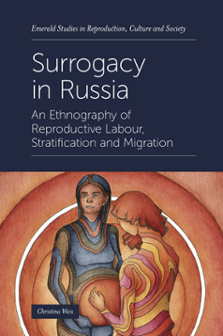
Index
Christina Weis
(De Montfort University, UK)
ISBN: 978-1-83982-897-3, eISBN: 978-1-83982-896-6
Publication date: 19 October 2021
This content is currently only available as a PDF
Citation
Weis, C. (2021), "Index", Surrogacy in Russia (Emerald Studies in Reproduction, Culture and Society), Emerald Publishing Limited, Leeds, pp. 171-172. https://doi.org/10.1108/978-1-83982-896-620211025
Publisher
:Emerald Publishing Limited
Copyright © 2021 Christina Weis. Published under exclusive licence by Emerald Publishing Limited
INDEX
Agency arrangements
, 59–60
Altruism
, 42
Awareness of surrogacy
, 23–26
Bourdieu’s theory of convertibility of capital
, 30, 82
Childbirth
, 73–77
Client parents
, 11–12, 55–56, 58, 91, 121–122
Commercial surrogacy
, 119–121
agencies
, 36–37
Commodification
, 58
Commuting arrangements
, 99–103
Commuting surrogacy worker
, 81–82, 84
Continuous motion
, 99–103
COVID-19
, 111
impact
, 111–113
pandemic
, 119
Current liberal policy context, challenges and potential changes to
, 114–118
Departure
, 103–108
Direct or agency-mediated surrogacy arrangement
, 58–65
Disruptions
, 111–113
Embryo transfer (s)
, 92–96
Emotion
‘in the field’
, 21–22
work
, 21, 36
Employee–employer arrangement
, 70–71
Financial penalties
, 14–15
Framing of surrogacy
, 122–123
Gabriela’s story
, 79–80
Geographic stratification
, 82
in selecting and paying surrogacy workers
, 86–92
Geopolitical stratification
, 82
in selecting and paying surrogacy workers
, 86–92
Graded payment schemes
, 88–92
(Im)mobility, nine months of
, 96–103
In vitro fertilisation (IVF)
, 5–6
Legal settings of surrogacy in Russia
, 8–15
Lived realities of mobilised and immobilised ‘carriers’
, 92–103
Meddesk. ru website
, 11–12, 84
Methods, sample and recruitment
, 17–20
Migrant surrogacy worker
, 81–82, 84, 96, 99
Mobility
, 96
Moral
, 33–34
Non-compliance
, 14–15
Philanthropic motives
, 29
Pre-term births
, 14
Pregnancy
, 96–103
Provincial surrogacy worker
, 86–88
Racialized imaginaries
, 46–52
Reconfigurations
, 114–118
Relational work
, 55, 65–66
Relationships
, 55
childbirth
, 73–77
direct or agency-mediated surrogacy arrangement
, 58–65
don’t work
, 71–73
as duty
, 65–69
personal relationships
, 71
surrogacy worker and client parents
, 55–56
work
, 65, 69, 71, 73
Repro-hubs
, 82, 86–87
Reproductive capital
, 30, 57
Reproductive migrations
, 81
delivery and departure
, 103–108
geographic and geopolitical stratifications in selecting and paying surrogacy workers
, 86–92
lived realities of mobilised and immobilised ‘carriers’
, 92–103
Russia’s Repro-hubs, St. Petersburg and Moscow
, 82–86
Reproflows
, 82–83
Russian Association of Human Reproduction (RAHR)
, 8
Russian public attitudes to surrogacy
, 23–24
SARS-CoV-2
, 111
Serious games
, 56
Social organisation of surrogacy in Russia
, 8–15
Social relations
, 56
St. Petersburg
, 1–2
Stratified reproduction
, 82
Subsistence farming
, 87–88
Sudden infant death syndrome (SIDS)
, 114–115
Surrogacy
, 5–6, 111
agencies
, 11, 19, 21, 44
arrangements
, 5–6, 24
awareness of
, 23–26
Bill
, 119–120
exclusive
, 42–43
gestation as work
, 26–30
hubs
, 82
pregnancy
, 1
research matters
, 15–17
in Russia
, 6, 8, 23, 41
types of surrogacy
, 5
Surrogacy workers
, 1, 11–14, 18, 23, 121–122
challenging assumptions of motherhood
, 33–38
make decision
, 62–65
organising
, 38–41
perception of relationship to surrogate child
, 30–33
selecting docile, healthy and ‘poor, but not too poor’ worker mother
, 41–46
VIP arrangements
, 64
- Prelims
- Prologue: From Moldova to Russia for Surrogacy. Gabriela's Story
- Chapter 1 Introduction: Surrogacy in Russia
- Chapter 2 Becoming a Surrogacy Worker
- Chapter 3 Making the Relationship Work
- Gabriela's Story Continued
- Chapter 4 Reproductive Migrations
- Chapter 5 Disruptions and Reconfigurations
- Conclusion: At Crossroads
- Appendix 1 Overview of Participants
- Appendix 2 Notes on Research Relationships
- Appendix 3 Emotion Work
- Appendix 4 Surrogacy Workers' Accommodations
- References
- Index